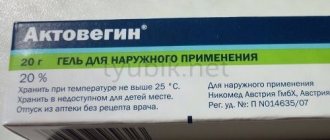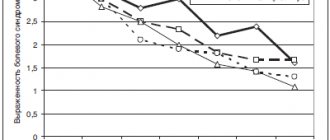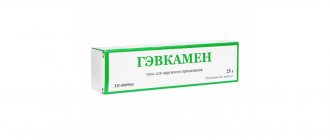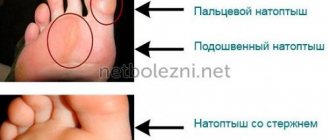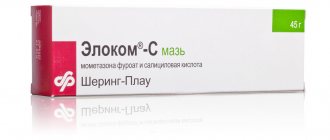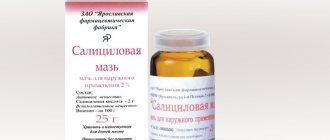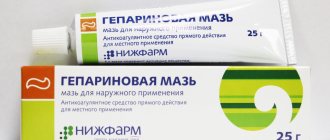The topical drug Finalgon is one of the most effective for various joint and muscle pathologies. Thanks to a combination of analgesic and irritating substances, it quickly relieves the painful symptoms of sciatica, lumbago, and relieves pain from bruises and sprains. The product has two convenient release forms for ease of application and does not cause adverse systemic reactions in the body.
Pharmacodynamics and pharmacokinetics
Pharmacodynamics
The ointment contains two drugs: nonivamide , a capsaicin derivative isolated from pepper and having a local irritant effect, and nicoboxil, which has a pronounced vasodilating effect. The mechanism of action is associated with stimulation of visceral skin receptors and increased local blood circulation, which leads to analgesic, warming and antispasmodic effects.
The complex action of the two substances eliminates muscle pain and improves joint mobility. The action manifests itself locally. The appearance of redness immediately after applying the ointment indicates penetration of the components into the skin. The maximum effect is observed after 30 minutes.
Pharmacokinetics
Not studied.
Mechanism of action of Finalgon
Nonivamide in the composition of the drug, upon contact with the skin, irritates superficial nerve endings and dilates the vessels of the capillary network. Thanks to this, blood flow to the affected area increases, microcirculation is stimulated, and swelling resolves faster. The burning and tingling sensation caused by capsaicin leads to a reduction in pain, spasms, helps restore the mobility of damaged structures, and is distracting in case of severe pain.
Nicoboxil, which is contained in cream and ointment several times more than nonivamide, has a more pronounced vasodilating and warming effect. Its contact with the skin causes a sensation of intense heat, similar to the effect of mustard plasters. Both active substances act on pain prostaglandins, reducing the symptoms of muscle and joint diseases.
The effect of the medicine begins 3-5 minutes after applying it to the skin. The therapeutic effect increases within half an hour and lasts for about 2–4 hours. A feeling of warmth, redness and tingling of the skin develops locally: only in places where the drug comes into contact with the body, without spreading throughout the body.
With repeated applications of Finalgon, the analgesic effect of the drug increases and lasts longer than with the first use, since the sensitivity of the nerve endings to it increases.
Finalgon ointment, instructions for use (Method and dosage)
Before starting treatment, you need to apply a small amount of ointment to a limited area of skin and evaluate the reaction. At one time, 0.5 cm of ointment is applied to the skin using an applicator on a painful area measuring 10x10 cm. Use 2-3 times a day. After applying the drug, wash your hands with soap.
If necessary, you can enhance the effect of the ointment by covering the area of application with a woolen cloth.
Do not wash off the ointment with hot water or take a shower after applying it.
The instructions for use of Finalgon contain a warning that applying an excessive amount of the drug may cause the appearance of vesicles . Avoid getting the drug on your face, nose or eyes. This can lead to swelling of the face, inflammation of the conjunctiva, and burning in the eyes. If it gets into the mouth, discomfort occurs and stomatitis . With repeated use, the response to the drug decreases, so an increase in dose may be required.
Finalgon in the fight against pain
F
inalgon is a topical agent that is a combination of two vasodilators: nonivamide, a synthetic analogue of capsaicin, and nicoboxil, a derivative of nicotinic acid.
The drug belongs to the group of skin irritants
that cause:
1. Local effects: hyperemia, swelling, irritation of sensory receptors (pain, burning)
2. Reflex effects:
• axon-reflexes
• reflex irritation of the respiratory and vasomotor centers from any area of the skin, especially from the skin of the face
• stimulation of the hypothalamus-pituitary-adrenal system, increased release of adrenocorticotropic hormone, glucocorticoids
3. Humoral effects: entry into the bloodstream of breakdown products of tissue proteins, histamine and other mediators.
The distracting effect of the drug is based on irritation of areas of the body surface, which is accompanied by a change in the functional state of certain organs. In addition, the influence of irritating substances is carried out on the corresponding organs through trophic reflexes - nervous influences on metabolism in tissues. The mechanism of the “distracting” action is very complex and has not been fully elucidated. However, it is known that all reflexes from skin receptors, including trophic ones, the so-called cutaneous-visceral ones, are directed mainly to internal organs that receive innervation from the same segment of the spinal cord. For this reason, it is necessary to rationally select the site of application of the irritating agent. The action of Finalgon differs from the mechanism of action of non-steroidal anti-inflammatory drugs that suppress cyclooxygenase and prostaglandin synthesis. The reduction of soft tissue tenderness achieved by using irritants is based on the principles described and is widely used in rheumatology and sports medicine. Irritants have an analgesic effect and increase blood supply to the muscle. Improved blood supply leads to muscle relaxation and increased cellular regeneration. This leads to relief of chronic pain due to degenerative and inflammatory lesions of the musculoskeletal system. Pain associated with muscle strain or injury is also reduced.
The mechanism of action of Finalgon is associated with the influence of its components on receptor complexes involved in the formation and perception of pain
. The natural substance capsaicin and its synthetic analogue, nonivamide, are acid derivatives of homovanillin, slightly different in the structure of the alkyl chain. Their pharmacological action is identical.
Painful stimuli act on nerve endings, which are represented by C-fibers, which have a 3-10 layer structure and a thickness of about 2 microns. 90% of pain receptors respond to thermal, mechanical and chemical stimuli. Being actually pain sensors, C-fibers carry the pain signal to the spinal cord, and then through ascending pathways it is sent to the brain, where pain suppression centers can affect the degree of pain. Understanding the fundamental cellular and molecular mechanisms of action of irritants has been made possible by the discovery of a potent capsaicin analog, resiniferatoxin, isolated from Euphorbia resinifera and the synthesized capsaicin antagonist, ofcapsazepine. When receptors are excited by capsaicin or its analog nonivamide, nonselective cation channels open, permeability to sodium and calcium ions increases, which leads to depolarization of the neuron membrane and the release of neuropeptides. In addition, stimulation of skin pain receptors of both C-fibers and thin myelin fibers, persistent depolarization of the membrane lead to depletion of neurotransmitters, in particular norepinephrine, and complete blockade of pain stimuli, which is perceived as analgesia [1,2].
Nicoboxil enhances the effect of nonivamide and causes direct expansion of capillaries, improving microcirculation. Therefore, the use of Finalgon is accompanied by redness, a feeling of warmth and the elimination of pain.
.
Finalgon compares favorably with other locally irritating drugs. It activates metabolism, ensures dilation of blood vessels, hyperemia, increased blood flow, increased extensibility of connective tissue and muscles while decreasing muscle tone.
Unlike Finalgon, drugs containing menthol cause a feeling of cold, combined with minor pain relief. With prolonged use of menovazine, dizziness, general weakness, and decreased blood pressure are possible. Preparations based on bee and snake venom often cause allergic reactions and have many contraindications (for example, acute infectious diseases, tuberculosis, hepatitis, diabetes mellitus, organic diseases of the central nervous system, pregnancy, etc.). Finalgon is usually well tolerated
. In rare cases, allergic skin reactions may occur. It is also not applied to wounds and areas of skin with impaired permeability, to the neck, inner thighs and abdomen.
Finalgon is used for pain in muscles and joints, injuries to muscles and ligaments, inflammation of the joints and peripheral circulation disorders.
. It is highly effective for radiculitis, arthritis, and neuralgia. Finalgon ointment acts as an effective irritant and as a thermal patch.
For a palm-sized area of skin, it is recommended to squeeze out a column of the drug just 0.5 cm long from a tube (the tube contains a total of 180 doses of the drug, which allows for several courses of therapy). The drug is rubbed into the affected part of the body and surrounding tissue with light massaging movements.
Assessment of the effects of irritants was previously based solely on subjective methods. The degree of pain and dysfunction was usually assessed by patients, and objective recording of effects presented significant difficulties. The effectiveness of Finalgon was assessed using modern examination methods, including the laser method using Doppler equipment. Previously obtained information about the effectiveness of the ointment and its constituent substances was confirmed. When assessing the degree and rate of development of the hyperemia reaction, differences were identified in the onset and duration of action of nicoboxil and nonivamide. When used in combination in Finalgon ointment, the medicinal substances potentiated each other's effects. Hyperemia and analgesia developed almost immediately after applying the ointment and lasted for several hours, which clearly exceeded the results of using individual substances.
Josenhans [3] used Finalgon ointment in 60 patients with shoulder pain due to osteochondrosis of the cervical spine, which is often accompanied by impaired peripheral blood flow. He recorded an increase in skin temperature of 5°C at the site of application of the ointment and by 3.5°C on the skin of the index finger compared to the use of placebo ointment, which caused an increase in temperature of only 0.2°C.
The use of Finalgon was studied in 1791 patients with rheumatic diseases, neuralgia, soft tissue bruises, and peripheral circulatory disorders. In the observations of Brill [4], Haase and Haslreiter [5], Furtenbach [6], Geyer [7], Lemke [8] and Chitil and Ortner [9], all patients noted a feeling of warmth that arose after a short period of time and continued until 6 o'clock. The feeling of warmth was accompanied by a decrease in pain and easing of muscle tension. When first applied, the feeling of warmth was perceived by some patients as a burning sensation, which lost intensity with subsequent applications of the ointment. In addition, it was noted that the feeling of warmth arose again under the influence of external factors (bed, bath) and during exercise.
Benz [10] reported on 1234 patients in whom the use of Finalgon led to a satisfactory reduction in muscle tension and pain, with the majority of patients reporting the disappearance of pain.
More recent clinical data also confirm the high effectiveness of capsaicin in patients with osteoarthritis of the knees, hips and rheumatoid arthritis
[11,12].
The effect of Finalgon on sports injuries was studied by Hainbock [13]. In 70 cases of muscle bruises and sprains or joint injuries, he found an immediate decrease in muscle stiffness, pain relief, rapid resolution of effusions and swelling, and rapid restoration of tissue damage. An earlier start to training with active movements became possible for 50 student athletes (30 men and 20 women) and 121 professional athletes. Kochner [14] studied the preventive effect of Finalgon, prescribing the ointment in two ways - applying it daily in the morning before starting a workout or in the evening - to skin areas along the projection of painful muscles. The ointment was applied to large surfaces of the skin of the upper extremities, shoulder girdle and lower extremities. At the same time, no undesirable skin reactions, disorders of microcirculation, breathing or digestion were observed. Despite intense training, none of the athletes experienced muscle strain, and no tendon or ligament damage was noted.
In 56 athletes, Aicher et al used Finalgon for therapeutic purposes for sports injuries: muscle strain, hematomas, sprains, dislocations and bone fractures. In all cases, they observed an improvement in the condition: resolution of hematomas, disappearance of edema, increased muscle elasticity
[15].
In local irritant therapy, a combination of drugs acting on capsaicin-sensitive receptors (nicoboxil) with a vasodilator derived from nicotinic acid can be even more widely used. Information obtained in recent years about the preventive and therapeutic effects of Finalgon opens up new possibilities for the treatment of diseases accompanied by pain and trophic disorders.
The list of references can be found on the website https://www.rmj.ru
Combined preparation for external use –
Finalgon (trade name)
(Boehringer Ingelheim)
References:
1. Szolcsany J. (1991): Perspektive of Capsaicin-type Agents in Pain Therapy and Research. Kluwer Academic Publishers Winston C. B. Parris.
2. Maggi CA The pharmacology of the efferent function of sensory nerves. J. Auton. Pharmac.(1991) 11,173–208.
3. Josenhans G. (1954): Skin segment and peripheral blood circulation in rheumatic illnesses. Dtsch. med. Wschr. 79:505–507.
4. Brill F. (1952): Clinical Report on Final Point. Pro. Med. (Munisch), 21: 429–431.
5. Haase W. & E. Haslreiter (1953): Percutaneous heat-sensitising therapy. Arztl. Praxis 5:2.
6. Furtenbach W. (1954): Experience with Final point in the treatment of rheumatic illnesses. Vienna. med. Wschr. 104:853–854.
7. Geyer F., M.Neumayer & K.Schmidt (1956): Percutaneous heat-sensitising therapy with Final ointment. Vienna. med.Wschr.106:233–234.
8. Lemke W. (1957): Experience with hyperaemizing measures in non-rheumatic indications. Landarzt 33:1055–1057.
9. Chitil W. & H. Ortner (1959): Clinical experience with Final point in a total of 26 cases. Prakt. Arzt (Vienna) 13: 201–207.
10. Benz R. (1959): On the treatment of vertebragene pain symptoms with Finalgon ointment and liniment. Med. 48:2355–2358.
11. Deal C.; Schnitzer TJ; Lipstein E.; Seibold JR; Stevens RM; Levy MD; AlbertD. & Renold F. (1991): Treatment of Arthritis with Topical Capsaicin: A Double–blind Trial. Clin. Ther. 13: 383–395.
12. McCarhy GM & McCarthy DJ (1992): Effect of Topical Capsaicin in the Therapy of Painful Osteoarthritis of the Hands. J. Rheumatol. 19; 604–607.
13. Hainbock W. (1955): Experience with Final point in sports injuries. Vienna. med.Wsch. 105: 147–148.
14. Kochner G. (1955): Prevention and therapy of frequent sports injuries with hyperaemic substances. Sportmed.6: 42–44/56–57.
15. Aicher B, Dr.M. Stucker and Prof. Dr. P. Altmeyer. Medication for Skin–sensitising Therapy. Pharmacists Journal. Vol.11/96. 18th.Year. Pages 44–50.
Overdose
An overdose occurs when excessive amounts of the drug are used and is manifested by the appearance of vesicles at the site of application of the ointment.
Systemic reactions: increased temperature, redness of the upper body, flushing, decreased blood pressure, painful hyperemia . Treatment of local reactions consists of removing excess drug with vegetable oil and from the mucous membranes of the eyes with medical petroleum jelly.
Symptomatic treatment is used for systemic reactions.
Analogues of Finalgon
Level 4 ATX code matches:
Dolobene
Nayatoks
Apizartron
Bee venom
Gavkamen
Dimexide
Menthol oil
Gum turpentine
Capsicam
Tizol
Camphor alcohol
Turpentine ointment
Formic alcohol
Mataren Plus
Dimethyl sulfoxide
Fast Relief
Betalgon and Betanicomylon ointments are synonyms and contain the same active ingredient. Analogues of Finalgon are similar in their mechanism of action to ointments Alvipsal , Vipralgon , Viprosal .
Reviews about Finalgon
What is Finalgon ointment for? It is used for bruises, injuries, arthritis , pain in the joints and spine. The ointment contains two substances with an analgesic and vasodilating effect, which provide a quick effect - pain is eliminated in 20 minutes.
Reviews of Finalgon ointment reflect the effectiveness of the ointment for various diseases and situations, quick and long-lasting pain relief, and a distracting effect.
- “... It is used very economically, lasts a long time, and is effective. Quickly warms the joint and relieves pain.” “... Excellent for helping with injuries and bruises.”
- “... I’ve helped out more than once, this ointment helps a lot. You feel a pleasant warmth, the pain goes away, the movements in the joint improve.”
- “... It warms up quickly, the main thing is not to overdo it with the dose. I was running around with a “flaming” back, not knowing what to do. But it helped with myositis.”
- “... Don’t repeat my mistake - don’t apply too much! It burns strongly if applied in large quantities!”
How to wash off Finalgon from the skin if you accidentally applied a lot of ointment and unbearable burning pain appears?
Under no circumstances should you wash it off with water, as contact with it will intensify the burning sensation. Then how to wash off Finalgon? The ointment is removed from the surface of the skin using a cotton swab moistened with vegetable oil or rich cream - the burning sensation is significantly reduced and relief occurs.
And one more warning - use the drug according to indications. The sensational news that appeared on the Internet - “Finalgon against prostatitis” has no basis. Those cases when the ointment “helped” apparently had nothing to do with this disease. Most likely, there was a disease of the neuromuscular system of the perineum. Indications for the use of this drug do not include the treatment of prostatitis , which is caused by pathogenic microorganisms and the main treatment is antibiotic therapy.
Indications
It is recommended to use Finalgon to improve blood circulation, eliminate pain in muscles and joints, and in the complex treatment of damage and inflammation of the musculoskeletal system. Its scope of use includes:
- rheumatic processes;
- arthralgia;
- myalgia;
- consequences of ligamentous injuries;
- neuralgic manifestations;
- sciatica, lumbago;
- symptoms of osteochondrosis;
- sports overload of muscles and joints.
Finalgon helps prevent exacerbation of chronic inflammatory diseases after prolonged exercise or hypothermia. It restores peripheral blood circulation in vegetative vascular pathologies. Athletes sometimes use it to warm up and improve blood flow to muscles before long workouts. According to reviews, Finalgon cream promotes the resorption of cellulite in the subcutaneous tissue if used in combination with special massage procedures. The irritating effect of the components has the same mechanism as most cosmetic anti-cellulite products.
Finalgon price, where to buy
You can buy the drug at any pharmacy. The price of Finalgon ointment in 20 g tubes ranges from 262 rubles. up to 456 rub.
- Online pharmacies in RussiaRussia
- Online pharmacies in UkraineUkraine
- Online pharmacies in KazakhstanKazakhstan
ZdravCity
- Finalgon ointment 20g Globofar Pharmaceutical Products
396 RUR order - Finalgon cream for external use. approx. tube 35gS.P.M. ContractPharma GmbH and Co. KG, Germany
RUB 432 order
Pharmacy Dialogue
- Finalgon cream (tube 35g)Contract Pharma
RUR 434 order
- Finalgon ointment tube 20g Boehringer Ingelheim.
405 rub. order
show more
Pharmacy24
- Finalgon 20 g ointment Globofarm Pharmaceuticals Productions und Handelsgesellschaft mbH/Boehringer Ingelheim Pharma GmbH i Co.
90 UAH order
PaniPharmacy
- Finalgon ointment Finalgon ointment 20g Austria, Globopharm
100 UAH order
show more
